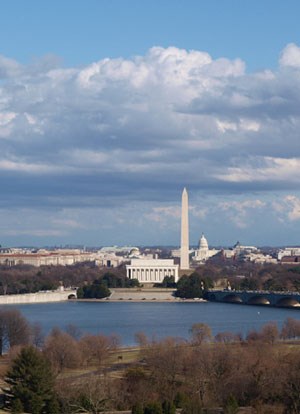
NPS Air Webcam Photo
The Clean Air Act gives the National Park Service (NPS) the tools and legal responsibility to protect air quality and sensitive resources in parks. Along with the National Park Service Organic Act, the Act is the primary legal basis for the National Park Service (NPS) role in air quality.
Federal land managers, including the NPS, are required by the Clean Air Act to prevent the significant deterioration of air quality in places of special natural, recreational, scenic, or historic value. This includes all national park units. The Clean Air Act also set up a process giving the NPS a role in decisions about new air pollution sources near parks. In addition, the NPS has a role in decisions about pollution control programs needed to prevent air quality from worsening and protect visibility.
What is the Clean Air Act?
The central goal of the Clean Air Act, a U.S. law originally passed in 1970, is safe and acceptable air quality for the entire nation. This core purpose is achieved through the attainment and maintenance of National Ambient Air Quality Standards (NAAQS). Primary standards are designed to protect public health while secondary standards are designed to protect the national “welfare” from all “known or anticipated adverse effects” of air pollution. The term “welfare” is broadly defined and includes ecosystems, sensitive plants, and visibility. The Environmental Protection Agency (EPA) has set National Ambient Air Quality Standards for six pollutants: carbon monoxide, lead, nitrogen dioxide, ozone, particulate matter, and sulfur dioxide.
Air in parts of the country may be cleaner or dirtier than the national standards for these pollutants at any given time. The 1977 Clean Air Act amendments added specific goals for areas with “clean” and “dirty” air. For the clean areas of the country, the Clean Air Act set up the Prevent Significant Deterioration (PSD) program to limit air pollution from new sources for the benefit of national parks and other special areas. The Clean Air Act provides additional protection for air quality, sensitive ecosystems, and clean, clear views (known as air quality related values or AQRVs). These protections apply to national parks larger than 6,000 acres and national wilderness areas larger than 5,000 acres that were in existence when the 1977 amendments were enacted, these are “Class I” areas. All other areas are “Class II”. The NPS manages 48 Class I areas. The 1977 Amendments also set a national goal to prevent future and remedy existing visibility impairments in Class I areas.
Because air pollution is often regional in nature, reductions in pollution to meet national air quality standards, or other Clean Air Act requirements, will also improve visibility and air quality related values in Class I and Class II national parks. For the “dirty” or nonattainment areas of the country, the Clean Air Act requires that “reasonable further progress” be made toward attainment of the standards.
How does it work?
States are primarily responsible for meeting the goals of the Clean Air Act. The Clean Air Act uses the State Implementation Plan (SIP) process to implement and enforce its goals. SIPs are prepared by states and describe the steps that will be taken to improve air quality in areas of the State that do not meet national air quality standards. These plans can include source specific emission limitations, transportation controls, and economic incentives for reducing pollution. SIPs commit a state to enforceable measures and emissions limits that will result in compliance with the national air quality standards within an established time frame. National park units must comply with state air quality rules and regulations. Information about state air quality programs is available on the State and Territorial Air Pollution Program Administrators/Association of Local Air Pollution Control Officials (STAPPA and ALAPCO) website. This site also contains links to all of the state air regulatory agencies which detail state air quality laws and regulations.
Clean Air Act regulatory actions—such as national ambient air quality standards, control technology requirements, state implementation measures, and individual source permits—can affect park air quality significantly. All of the Clean Air Act’s regulatory actions involve notice to the public of proposed actions and opportunity for comment.
Visit the Environmental Protection Agency Clean Air Act overview website to learn more milestones, programs, and implementation of the Act.
Last updated: February 14, 2018
